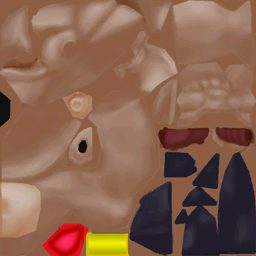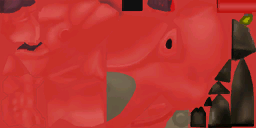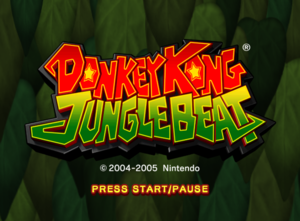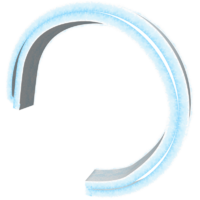Donkey Kong Jungle Beat
| Donkey Kong Jungle Beat |
|---|
|
Developer: Nintendo EAD[1]
|
To do:
|
Who needs controllers when you have bongos? Apparently, not Donkey Kong. Notable for being the first game in history to get the E10+ rating from the ESRB. It was later re-released on the Wii with new content and motion controls.
Contents
Unused Objects
Bloom Fairy
The model SoundFlowerFairy is a pink fairy with a different art style from the usual fairies. The name SoundFlower is how the game refers to the Bloom collectibles, which are spread by a pink fairy in the final game. This model uses bones to control the wings while the final fairy model uses texture animation instead, suggesting that the design change was made to save on resources. This model was removed from the Wii version.
Small Cactus Mine Platform
| VanishFloorA | VanishFloorB |
|---|---|
 |
 |
VanishFloorB is a smaller version of the breakable wooden platforms seen in the stage Cactus Mine, which use the model VanishFloorA. The smaller version has different vertex colors that give it the appearance of brighter lighting. Its size and bright lighting make it fit perfectly in the spot where the second breakable platform is used, under the Gale Hawg that guards the outdoor midpoint of the stage. However, the developers chose to instead reuse VanishFloorA at a smaller scale. The model was removed from the Wii version.
Quick Terrain
Most of the game's unused models are terrain models with specific designs. They are all composed of three parts with the same arrangement, have many polygons for curved surfaces, and all use .BMD instead of .BDL like the rest of the game's models. Because of how the models follow the same structure and polygons overlap on corners, it is likely that these models were created automatically from splines through the use of a development tool.
ClockBeltEnds depicts a stone end piece, possibly as a cap to a conveyor belt. The stage Clock Tower features conveyor belts, but they are all vertical and are part of the stage model itself rather than being separate objects. One of the objects loaded by the stage is also named ClockBeltEnds, but the model itself is not loaded. Because of this matching name, the model was kept in the Wii version.
DoubleLinedLift is an earthy wheel with a gap in the middle and grass growing along it. Strangely, the top part of the model extends out into the third dimension, much farther than any other regular object in the game.
RollingIceWall is a large C-shaped wheel made of ice. It is considerably larger than the other unused terrain models, and the gap is too large for Donkey Kong to jump across unless he were moving quickly, suggesting that it may have been intended as part of a Hoofer section.
| ClockBeltEnds | DoubleLinedLift | RollingIceWall |
|---|---|---|

|

|

|
Because of how the terrain is modeled, only the top half of the front textures are shown. All three textures become darker at the bottom, fitting of the game's cross-section environment designs.
Early Asteroid Belt Part
AttributedLandMeteoriteC is one of the quickly-generated terrain models, sharing the same textures as RollingIceWall. However, unlike those models, this one is actually used in the game, likely due to an oversight. The model is meant to be used as part of the icy terrain in the post-goal Hoofer section, specifically at the very end. Most of the stage's ice terrain is split into other AttributedLandMeteorite models, but the top layer that the player jumps across is part of the main stage model.
It is possible to see the model in-game by successfully performing all jumps in the Hoofer section. The front of the model has some Z-fighting with the regular terrain, and the top snow texture can be seen poking through the ground. This same mistake was carried over to the Wii version.
Unused Graphics
Early Textures
Rolling Frog
| Body texture | Tongue texture |
|---|---|
 |
 |
The separate tongue model for the Rolling Frog enemy uses an earlier version of the body texture with a different layout. The most notable difference is that the frog's cheek bares a symbol similar to the one for yin and yang, but without the dots.
Boss Hogs
| Body texture | Tail texture |
|---|---|
 |
 |
The separate tail model for the four warthog bosses each use an earlier version of the body texture with a different layout. All of them share a common difference in how the body is shaded, mostly the lack of highlights. For Rogue-Hog's textures here, that is the only notable difference.
| Body texture | Tail texture |
|---|---|
 |
 |
The early Mo-Hog texture shows that he originally had a white belly like Gloat-Hog.
| Body texture | Tail texture |
|---|---|
 |
 |
The early Bloat-Hog texture has lighter skin and a much darker belly.
| Body texture | Tail texture |
|---|---|
 |
 |
The early Gloat-Hog texture has light hooves and a much more vibrant pink for the eyes. The white belly also uses cooler colors for the shading, which was changed to warm colors in the final version.
Oddities
- Orco's internal name is Dolphin, despite being an orca (killer whale). While orcas are part of the dolphin family, it would be unusual for the developers to label it as a dolphin in the same way that it would be unusual to label a panda as just a bear. Additionally, while many of the character models have textures with names matching the model name, Orco's body texture is named syati after the Japanese word for orca (シャチ).
- The panda enemy Shaoshao's internal name is MiniPanda. Likewise, the floating enemy Miniga is named MiniIga. All other enemies with internal names starting with "Mini" are smaller versions of bosses or big enemies, but there are no bigger versions of either of these two enemies in the game. Neither enemy is smaller than Donkey Kong himself or other enemies without the "Mini" label, so it is unlikely that the name is in reference to their size. This suggests that there had been other related enemies or bosses planned that were cut after the smaller versions had been designed.
- The stage Ninjape Rally loads a common sky background model featured in several other stages, but since it already has its own background model, the common sky goes unseen.
- The vertically-moving platforms in the stage Primeval Ruins are named HangedCeilingA and B, despite not hanging from anything.
- The files AttributedLandRockAMat and BMat are extra copies of the texture archives used for the stage Asteroid Belt's ice terrain models, which instead use AttributedLandSnowAMat and BMat. These were removed from the Wii version.
- All of the polygons in the building mesh for the boss stage VS. Double Tusk are duplicated and inverted, doubling the polygon count with no benefit.
Internal Names
| To do: find a way to get list of Japanese level names to compare with internal names |
Unlike some of Nintendo EAD's other games, the internal file structure for Jungle Beat is very nicely organized. As such, characters and stages have internal names that they are consistently referred to by, many of which are the same as their official names in Japan.
- Ninja Kong, known as Bushido Kong (ブシドーコング) in Japan, is referred to as Miyamoto. This is likely a reference to Miyamoto Musashi, a legendary Japanese swordsman, rather than game designer Shigeru Miyamoto.
- Sumo Kong, known as Hyakkan Kong (ヒャッカンコング) in Japan, is referred to as Akebono. This is likely a reference to Akebono Tarō, a popular, then-recently-retired sumo wrestler.
- Karate Kong, known as Konfu Kong (コンフーコング) in Japan, is simply referred to as Konfu. This is likely not just an omission, as Dread Kong has "kong" in his internal name.
- The stage Magma Coliseum is referred to as InfernalZoo. This puts a different perspective on the theme of the stage, which has you fighting a bunch of enemies one after the other in a lava-filled cavern.
- The stage Asteroid Belt is referred to as UnderGroundMaze. While the stage is space-themed, this still does make sense as much of the stage takes place inside large, hollow asteroids.
- The effect manager object for wind effects is named WindWaker, a clear nod to one of the development team's previous titles.
References
- Games developed by Nintendo EAD
- Games published by Nintendo
- GameCube games
- Games released in 2004
- Games released in December
- Games released on December 16
- Games with unused areas
- Games with hidden development-related text
- Games with unused objects
- Games with unused graphics
- Games with unused models
- To do
- Donkey Kong series
Cleanup > To do
Games > Games by content > Games with hidden development-related text
Games > Games by content > Games with unused areas
Games > Games by content > Games with unused graphics
Games > Games by content > Games with unused models
Games > Games by content > Games with unused objects
Games > Games by developer > Games developed by Nintendo > Games developed by Nintendo EPD > Games developed by Nintendo EAD
Games > Games by platform > GameCube games
Games > Games by publisher > Games published by Nintendo
Games > Games by release date > Games released in 2004
Games > Games by release date > Games released in December
Games > Games by release date > Games released in December > Games released on December 16
Games > Games by series > Donkey Kong series







